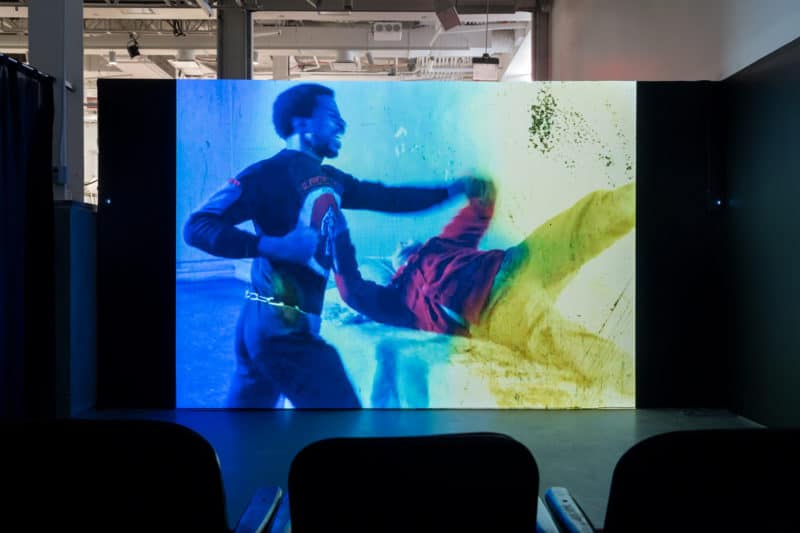In 2016, a year before the Slave Theater in Brooklyn’s Bed-Stuy neighborhood was demolished, the artist Crystal Z. Campbell was walking along Fulton Street with a friend. As they passed by the theater, the two decided to venture inside. Layers of paint were peeling from the ceiling and the floors were covered in bottles and empty food containers, but the murals of prominent black figures from history still held her gaze. It was her first time in the theater, which once held 534 seats and hosted rallies by Al Sharpton and a fiery speech by Khalid Abdul Muhammad, who was Louis Farrakhan’s assistant in the heyday of the Nation of Islam. (Muhammad famously—or notoriously—arrived in a Rolls Royce.)
In 1984, Judge John L. Phillips, Jr. bought what was then the Regent Theater at 1215 Fulton Street, along with the Black Lady Theater on Nostrand Avenue, to screen Hands Across Two Continents, his self-financed interracial love story set in ‘70s Brooklyn. Reportedly, no other theater at the time would screen it.
Phillips was a practicing judge, but he also held a black belt in karate, and championed black liberation through discipline and self-love. Martial arts films had been resonating with black theatergoers ever since Five Fingers of Death debuted in the US in 1973. The Black Panther Party for Self-Defense was preaching a message of revolution in cities across the country, a message echoed in such films, where “the winning formula called for an explosion of rage and retribution by a long-suffering protagonist who finally embarks on a journey of revenge against a vicious, amoral antagonist,” as Sundiata Keita Cha-Jua put it in his essay “Black Audiences, Blaxploitation and Kung Fu Films, and Challenges to White Celluloid Masculinity.”
After Phillips bought the two theaters, he commissioned artists to the paint murals of revolutionary heroes that Campbell would find there thirty years later; commanding the area above the popcorn stand were Toussaint L’Ouverture, the leader of the Haitian independence movement, and Bruce Lee. Phillips even opened his own dojo in Bed-Stuy, where he taught the “Gorilla-Gnat System of Scientific Movements and Defensive Fighting,” a style catering to young black men in the neighborhood. In court, he would announce from the bench that “‘kung-fu law’ was about to be practiced.”
Years later, when Campbell was wandering around the theater and stepping through the bits of installation and cans left by squatters, she accidentally kicked something heavy. It turned out to be a damaged 35mm film—one she suspected was made by Phillips himself. After a half-failed attempt at building her own reel-to-reel player, she took the undeveloped work, Go-Rilla Means War, to be professionally developed.
The resulting 19-minute fragment is unedited, an artifact from a place that is now unrecognizable. There are no titles, no soundtrack, no credits. Instead, Campbell narrates over the footage with her own text, inspired by the judge’s life and legacy. Some of the scenes can be difficult to make out, since the artist decided to have the film developed as-is, without restoration or repair. “I had to leave the dust, and dirt and debris intact,” she said, “because the film is an index of neglect.”
Campbell has given the theater a second life at BRIC House in Fort Greene, in a show that was on view until February 25; it will also screen at Visual Studies Workshop in Rochester from February 2 through March 16, 2018.
It begins with two young boys who meet a man outside of a bodega and venture into his house; later, a uniformed police officer with three other men kick down the door, but find only a dummy tied to a chair. Around 12-and-a-half minutes in, there’s a grainy scene set in a dojo, which sets up the final fight sequence. A group of revolutionaries stand in a line, wearing black uniforms with “Go-rilla means war” on the back and “Go-rilla Slave Go-rilla” on the front. These elite fighters then enter a building and put their martial arts skills to the test against henchmen who lurk inside. It’s a classic set-up for the grand finale, where the good guys win and evildoers are vanquished.
At the end of the film, Campbell-as-narrator details Phillips’ fate, describing how he had “no wife, no kids, no rights, [and] died alone.” She continues, “This is the story of how I found the film. You are watching a relic.” When the credits roll, the director is listed simply as “Unknown.”
A year after the artist discovered the footage, the building and surrounding area was sold to a developer for $18.5 million. “We’re in the middle of a new struggle for the movement, and we’re losing one of the landmarks that made it possible,” Al Sharpton told The New York Times.
With this in mind, the last film to be retrieved from the space exists as both a document and a mystery. “I know there’s something else out there that would help us put together the rest of this story,” Campbell said. No one has come forward yet.

